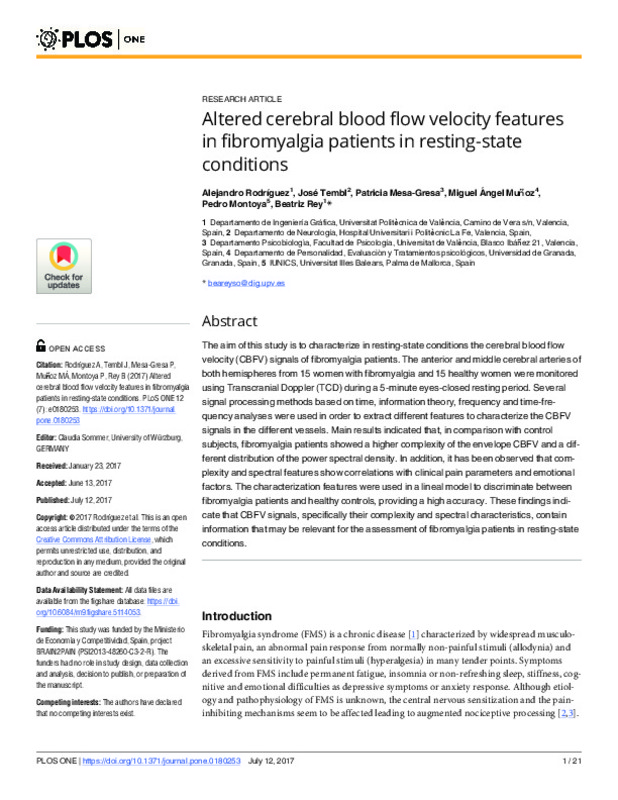JavaScript is disabled for your browser. Some features of this site may not work without it.
Buscar en RiuNet
Listar
Mi cuenta
Estadísticas
Ayuda RiuNet
Admin. UPV
Altered cerebral blood flow velocity features in fibromyalgia patients in resting-state conditions
Mostrar el registro sencillo del ítem
Ficheros en el ítem
| dc.contributor.author | Rodríguez Ortega, Alejandro
|
es_ES |
| dc.contributor.author | Tembl, Jose
|
es_ES |
| dc.contributor.author | Mesa Gresa, Patricia
|
es_ES |
| dc.contributor.author | Muñoz, Miguel Angel
|
es_ES |
| dc.contributor.author | Montoya, Pedro
|
es_ES |
| dc.contributor.author | Rey, Beatriz
|
es_ES |
| dc.date.accessioned | 2018-09-25T07:13:01Z | |
| dc.date.available | 2018-09-25T07:13:01Z | |
| dc.date.issued | 2017 | es_ES |
| dc.identifier.issn | 1932-6203 | es_ES |
| dc.identifier.uri | http://hdl.handle.net/10251/108064 | |
| dc.description.abstract | [EN] The aim of this study is to characterize in resting-state conditions the cerebral blood flow velocity (CBFV) signals of fibromyalgia patients. The anterior and middle cerebral arteries of both hemispheres from 15 women with fibromyalgia and 15 healthy women were monitored using Transcranial Doppler (TCD) during a 5-minute eyes-closed resting period. Several signal processing methods based on time, information theory, frequency and time-frequency analyses were used in order to extract different features to characterize the CBFV signals in the different vessels. Main results indicated that, in comparison with control subjects, fibromyalgia patients showed a higher complexity of the envelope CBFV and a different distribution of the power spectral density. In addition, it has been observed that complexity and spectral features show correlations with clinical pain parameters and emotional factors. The characterization features were used in a lineal model to discriminate between fibromyalgia patients and healthy controls, providing a high accuracy. These findings indicate that CBFV signals, specifically their complexity and spectral characteristics, contain information that may be relevant for the assessment of fibromyalgia patients in resting-state conditions. | es_ES |
| dc.description.sponsorship | This study was funded by the Ministerio de Economía y Competitividad, Spain, project BRAIN2PAIN (PSI2013-48260-C3-2-R). | es_ES |
| dc.language | Inglés | es_ES |
| dc.publisher | Public Library of Science | es_ES |
| dc.relation.ispartof | PLoS ONE | es_ES |
| dc.rights | Reconocimiento (by) | es_ES |
| dc.subject.classification | EXPRESION GRAFICA EN LA INGENIERIA | es_ES |
| dc.title | Altered cerebral blood flow velocity features in fibromyalgia patients in resting-state conditions | es_ES |
| dc.type | Artículo | es_ES |
| dc.identifier.doi | 10.1371/journal.pone.0180253 | es_ES |
| dc.relation.projectID | info:eu-repo/grantAgreement/MINECO//PSI2013-48260-C3-2-R/ES/MODULACION DE LA ACTIVIDAD CEREBRAL PARA ALIVIAR EL DOLOR: APORTACIONES DEL DOPPLER TRANSCRANEAL/ | es_ES |
| dc.rights.accessRights | Abierto | es_ES |
| dc.contributor.affiliation | Universitat Politècnica de València. Departamento de Ingeniería Gráfica - Departament d'Enginyeria Gràfica | es_ES |
| dc.contributor.affiliation | Universitat Politècnica de València. Instituto Interuniversitario de Investigación en Bioingeniería y Tecnología Orientada al Ser Humano - Institut Interuniversitari d'Investigació en Bioenginyeria i Tecnologia Orientada a l'Ésser Humà | es_ES |
| dc.description.bibliographicCitation | Rodríguez Ortega, A.; Tembl, J.; Mesa Gresa, P.; Muñoz, MA.; Montoya, P.; Rey, B. (2017). Altered cerebral blood flow velocity features in fibromyalgia patients in resting-state conditions. PLoS ONE. 12(7):e0180253 (1)-e0180253 (21). https://doi.org/10.1371/journal.pone.0180253 | es_ES |
| dc.description.accrualMethod | S | es_ES |
| dc.relation.publisherversion | https://doi.org/10.1371/journal.pone.0180253 | es_ES |
| dc.description.upvformatpinicio | e0180253 (1) | es_ES |
| dc.description.upvformatpfin | e0180253 (21) | es_ES |
| dc.type.version | info:eu-repo/semantics/publishedVersion | es_ES |
| dc.description.volume | 12 | es_ES |
| dc.description.issue | 7 | es_ES |
| dc.identifier.pmid | 28700720 | en_EN |
| dc.identifier.pmcid | PMC5507513 | en_EN |
| dc.relation.pasarela | S\343767 | es_ES |
| dc.contributor.funder | Ministerio de Economía y Competitividad | es_ES |








